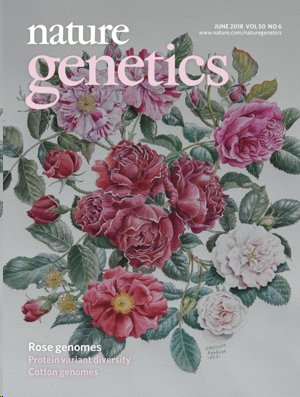The roses: The decoded genome
From the origin of modern roses to the characteristics of the flower
The rose... an ornamental plant emblematic of the history of humanity from a cultural and economic point of view.
Successfully carried out by an international consortium involving the Lyon ENS, IPS2, INRA, CEA, CNRS and Claude Bernard Lyon 1 University, the decoding of the rose genome made it possible to trace the respective contributions of European and Chinese roses to the modern rose genome and to identify all the genes involved in the perfume and colour biosynthesis pathways.
Two IPS2 teams, the Floral Development and Sex Determinism team (A. Bendahmane) and the Chromatin Cell Cycle and Development team (M. Benhamed) contributed to this work. Our contribution helped to decipher the epigenome and to study the genetic biodiversity of the rose.
Published in the journal Nature Genetics on April 30, 2018, this work is essential to design varieties that will optimize flower qualities in a context of global changes.
Celebrated since Antiquity by many artists, appreciated for its perfume and the beauty of its flower, the rose is today the most bought cut flower in France while the rose is an ornamental plant impossible to circumvent of our gardens and our balconies, fruits of numerous crossings and hybridizations. Thanks to an international consortium involving INRA, ENS de Lyon, CEA, CNRS and Claude Bernard Lyon 1 University, the genome of the rose has just been deciphered, an essential step in understanding its biology and the origin of its diversity.
Eight years of work combined with the most innovative strategies and tools have made it possible to sequence and decipher all the genetic information carried by the seven pairs of Rosa chinensis "Old blush" chromosomes and to characterize all of its 36,377 genes. The comparison of this reference genome of the genus Rosa with those of other plants of the Rosaceae family (strawberry, raspberry, apple, pear, peach, plum...) showed that rose bush, strawberry and raspberry are very similar and allowed to reconstitute the ancestral genomes during the evolution of the Rosaceae family.
Translated with www.DeepL.com/Translator
Référence:
The Rosa genome provides new insights into the domestication of modern roses.
Raymond O, Gouzy J, Just, Badouin H, Verdenaud M, Lemainque A, Vergne P, Moja S, Choisne N, Pont C, Carrère
S, Caissard JC, Couloux A, Cottret L, Aury JM, Szecsi J, Latrasse D, Madoui MA, François L, Fu XP, Yang SH, Dubois
A, Piola A, Larrieu A, Perez M, Labadie K, Perrier L, Govetto B, Labrousse Y, Villand P, Bardoux C, Boltz V, Lopez-
Roques C, Heitzler P, Vernoux T, Vandenbussche M, Quesneville H, Boualem A, Bendahmane A, Liu C, Le Bris M,
Salse J, Baudino S, Benhamed M, Wincker P, Bendahmane M. Nature Genetics 2018, DOI: 10.1038/s41588-018-0110-3
